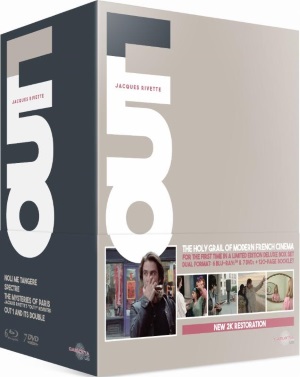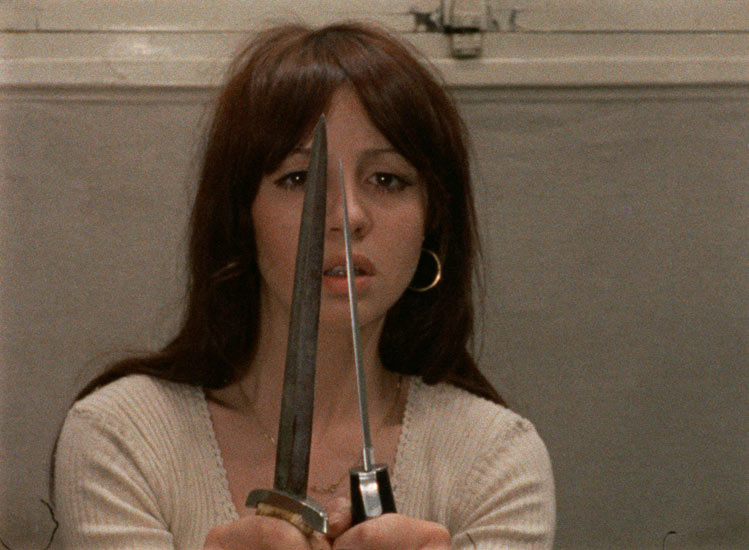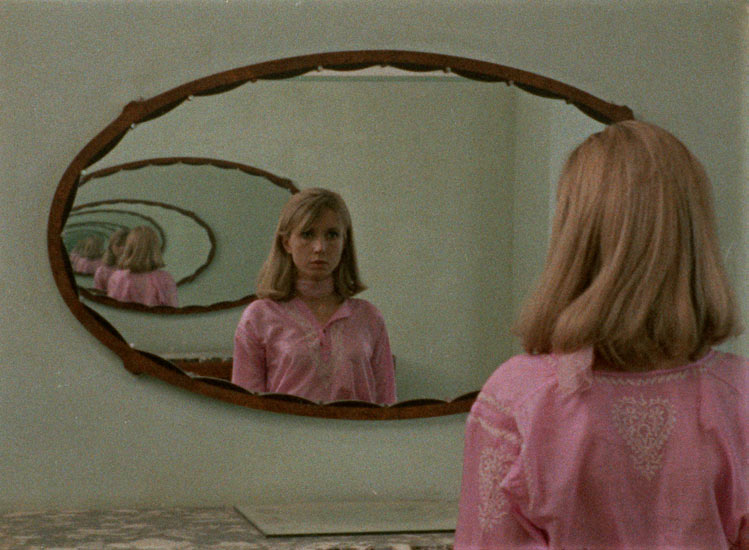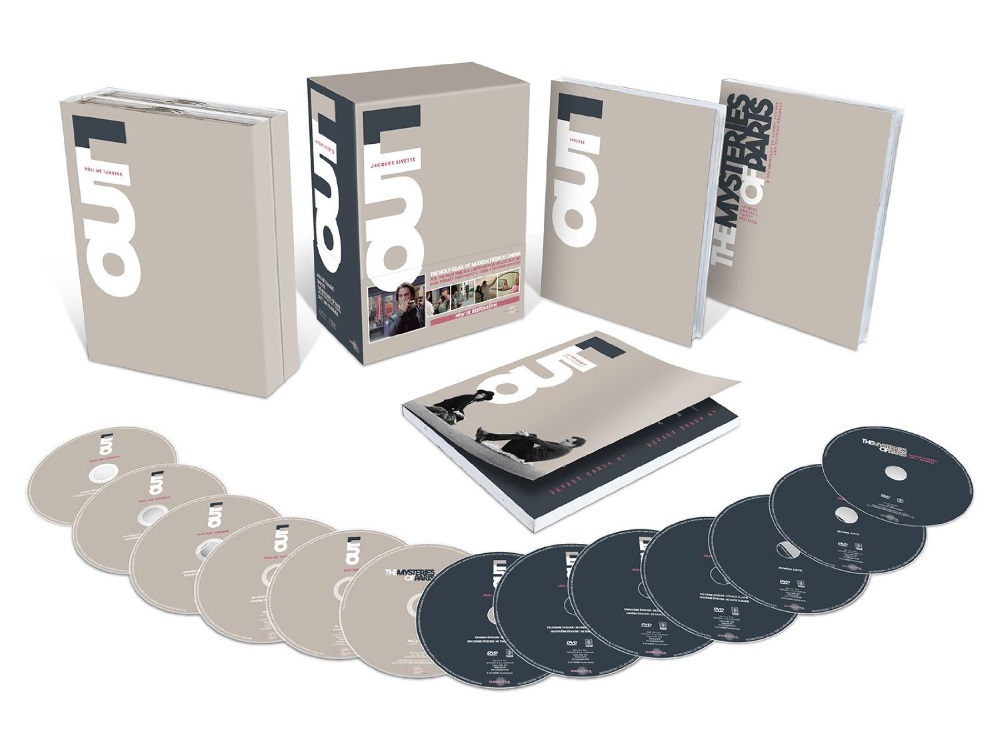 Jacques Rivette’s Out 1 (Kino Lorber / Carlotta, Blu-ray+DVD) has been one of the Holy Grails of international cinema since its premier screening in 1971. Rejected by French TV and, at over 12 1/2 hours in its initial cut, too long for theaters, the definitive editions wasn’t even completed until 1989. It showed on French and German TV but apart from periodic special screenings (including a handful of showings in the U.S. and Canada in 2006 and 2007) was impossible to see.
Jacques Rivette’s Out 1 (Kino Lorber / Carlotta, Blu-ray+DVD) has been one of the Holy Grails of international cinema since its premier screening in 1971. Rejected by French TV and, at over 12 1/2 hours in its initial cut, too long for theaters, the definitive editions wasn’t even completed until 1989. It showed on French and German TV but apart from periodic special screenings (including a handful of showings in the U.S. and Canada in 2006 and 2007) was impossible to see.
That changed in 2015 with a French digital restoration from the original 16mm negatives, a high-profile two-week run in New York (qualifying as the film’s American theatrical debut) followed by screenings across the country (including Seattle), streaming availability from the arthouse subscription service Fandor and a late 2015 disc release in France. Now 2016 brings this amazing Blu-ray+DVD combo box set release. It features not only the 13-hour Out 1: Noli me tangere (1971 / 1989) but the shorter Out 1: Spectre (1974), designed for a theatrical release after French TV balked at his original vision, plus an accompanying documentary and a booklet.
Out 1 is many things, not the least of which is a radical experiment in filmmaking and collaborative storytelling: a film completely improvised by the cast. Each actor was invited to create a character independently of one another and then interacted based on the situations of an outline developed by Rivette and Suzanne Schiffman and inspired by the “History of the Thirteen” novels by Balzac. Length was left open: the story would take as long to tell as the process demanded, and while Rivette was there to guide the process, he was also there to follow where the actors took it. The rhythms of the performances and interactions guided the shaping the film.
The film itself reflects its creation: two separate theater groups, each working on a different play by Aeschylus, work the material through acting exercises, each utilizing a different approach. One group is led by Lili (Michèle Moretti), who draws from dance and song to inform performance in her workshopping, the other by Thomas (Michael Lonsdale), whose improvisational exercises are meant to get in touch with the essence of character and the act of collaborative performance. The post-performance discussions conducted by Thomas, which analyze the experience as well as the effectiveness, could be comments on the process of the shooting itself. At least that’s my takeaway.
In addition to these groups are another matched pair. Jean-Pierre Leaud plays Colin, a deaf-mute who panhandles with enigmatic messages and “talks” through a harmonica, and Juliet Berto is petty thief Frédérique, who flirts with bar patrons and then steals their money. Colin is handed a letter that hints at a conspiracy of thirteen individuals (followed by two more enigmatic notes) and turns investigator, looking for secret messages coded in the messages and following clues to a group that meets in a counter culture storefront run by Pauline (Bulle Ogier). Frédérique steals letters with references to The Thirteen from a chess-playing businessman (Jacques Doniol-Valcroze) and tries to leverage them for the purposes of blackmail. Connections between the characters—who grow to include an author (Bernadette Lafont), a lawyer (Françoise Fabian), an intellectual (Jean Bouise), a gangster with aspirations to theater (Alain Libolt), and more—are discovered along the way and histories are revealed. There are also cameos by Rivette’s fellow filmmaker and former colleague Eric Rohmer (dryly funny as a Bazan scholar consulted by Colin in the “Third Episode”) and Barbet Schroeder.

Even for the French nouvelle vague this is an unconventional narrative. Leaud’s character isn’t identified by the name Colin until the fourth episode (though it is cited in the credits) and there is no effort to establish characters or relationships for the viewer, as the screenwriting manuals instruct. You pick up their names and their backstories as they come, piecing the world together along the way. Two seemingly central characters referenced in great detail never even appear. Storylines don’t follow any familiar paths and endeavors fall apart as outside forces and personal anxieties pull at the characters. This was produced in the wake of May 1968 and in some ways it is their response, both as a communal endeavor among collaborators with a shared vision and a portrait of idealists whose creations collapse for any number of reasons. To say that patience is called for is an understatement—I for one found the theater exercises of Thomas’ group, which Rivette allows to play out in long sequences, trying in the early episodes—and it will frustrate anyone waiting for a narrative payoff, something that explains everything that we’ve seen. But it’s a delight if you engage in the process and enjoy the personalities, the collisions of character, the unexpected textures and rhythms of the storytelling, and the odd bounces of the narrative. Out 1 musters the energy and enthusiasm and free-spirited filmmaking of the Nouvelle Vague that Rivette’s more famous colleagues left as the moved into their own comfort zones (Truffaut, Chabrol, Rohmer) or, in the case of Godard, discomfort zones.
Out 1 is Rivette redux. His engagement with actors is there on the screen, creating energy even in simple conversational scenes, and they are co-conspirators in his hide-and-seek narratives, where characters circle conspiracies and play blind man’s bluff through mysteries that may have no solution. His love of actors and theater, his passion for mysteries and conspiracies and puzzles, his play with doubles and reflections, and his freewheeling approach to storytelling is all here. While Rivette had television in mind for distribution (French TV turned it down at the time and it was nearly 20 years before it was broadcast) and he breaks it into eight chapters, he always saw it as a work of cinema and that’s how it plays. This isn’t a mini-series along the lines of Fassbinder’s Berlin Alexanderplatz or a serialized story like the contemporary cable or streaming model. This is a movie and the pleasures are as much in the invention and energy of the moment as in the accumulation of detail. It simply takes its time, and is best seen in parts spread out over time (though I would never deny anyone the pleasure of watching it in a single epic screening).

The complete 13-hour version was finished and presented in its final version in 1989. Carlotta Films restored this version from the 16mm negative, scanned in 4k and supervised by director of photography Pierre-William Glenn, and original sound mix, and remastered it in 2k for theatrical and video release. The producers of the restoration corrected damage to the materials but preserved the anomalies inherent in the original presentation; you’ll see stray hairs in the gate of the camera (preserved for posterity on the camera negative) in many shots. Rivette chose to keep some mistakes captured in the shooting if it meant preserving the integrity of the scene, especially in the midst of a long take. The futz on the frameline of some (actually quite a few) shots is simply a hallmark of the method of production, which he grabbed on the fly at a tremendous pace (the entire production was shot in six weeks). The presentation preserves the grain of the 16mm source, another distinctive texture of the film, and the odd intensity of the colors, a kind of saturation you don’t see in modern digital or even 35mm shooting.
The shorter Out 1: Spectre, which runs 255 minutes and is presented in two halves with an intermission, is not just a condensed version of the original cut but a reworking of the material (with some instances of alternate footage). Set in “Paris and its double,” this journey through the characters does away with most of the long takes and extended sequences (especially the theater exercises) and shuffles the B&W stills (which recap each episode in the long version) are shuffled through Spectre to fill in gaps and set a different narrative rhythm. Footage from the longer version, already scanned and restored, was used where possible, but a few alternate shots and sequences unique to Spectre were newly remastered for this presentation.

The 13-disc box set (6 Blu-rays, 7 DVDs), released stateside by Kino, features both versions and is identical to the French release but for the packaging and branding. It features the new documentary “The Mysteries of Paris: Jacques Rivette’s Out 1 Revisited,” directed by Robert Fischer and Wilfried Reichart, as a bonus program. The 2015 production features new interviews with actors Bulle Ogier, Michael Lonsdale and Hermine Karagheuz, cinematographer Pierre-William Glenn, assistant director Jean-François Stévenin and producer Stéphane Tchal Gadjieff, plus archival interviews with Rivette and others. The accompanying 120 page bilingual booklet features an illuminating essay by film critic Jonathan Rosenbaum, a champion of Rivette and Out 1, along with archival interviews and articles with members of the cast and crew and a collection of production stills.
With the release of Out 1 and last year’s Le Pont du Nord (1981) on Blu-ray and DVD by Kino Lorber, I think it’s fair to say that Rivette is finally getting his due. Criterion will bring out the American home video debut of his debut feature, Paris Belongs to Us (1961), in March, while Noroit (1976) and Duelle (1976) were released in the British Out 1 box set, and I still hold out hope for the eventual Blu-ray releases of Celine and Julie Go Boating (1974), announced by New Yorker a couple of years ago, and La belle noiseuse (1991), previously released on DVD by New Yorker but in desperate need of a remastered upgrade. Rivette is clearly an acquired taste. Here’s hoping more viewers are acquiring it.
Calendar of upcoming releases on Blu-ray, DVD, Digital, and VOD
TRAILER OUT 1 BY JACQUES RIVETTE from Carlotta Films on Vimeo.
















